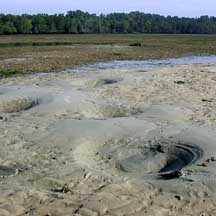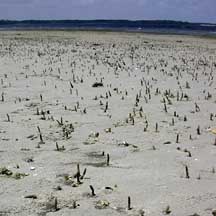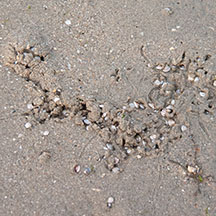 |
| ecosystems | rocky | sandy | seagrass | coral rubble | coral reef |
| index of concepts |
| Sandy
shore ecosystem updated Dec 2019 A natural sandy shore may appear dead, but is actually full of life if you take a closer look! Sandy ecosystems may be found near the high water mark, as well as on large sand bars that may form further away from 'dry land'. What is sand? Sand is made up of broken bits of rocks and shells and bones of sea creatures. Together, sand grains form an entire galaxy of invisible life in the sand. Each grain is surrounded by a thin film of water. Swimming about in this film are microscopic lifeforms. These microscopic lifeforms are eaten by tiny animals, which in turn are eaten by larger ones. Many food chains on a shore depend on such humble creatures. In Singapore, the sand grains of most of our natural shores are mostly made up of quartz grains. Sandy shores are often bare of seaweeds and seagrasses because the shifting sand grains provide an unstable substrate and there is less nutrients. But shores which are a little muddy or silty will have more plants. Where are the animals? Underground! Most sand-dwellers burrow deep into the sand to stay moist and cool at low tide. Here, they are also safer from predators. Living in sand is like living in moving sandpaper. Sand particles are abrasive and move with the currents. Many sand dwellers thus live in protective tubes or shells. |
 Large sandy shores at East Coast Park are alive with cool animals! Large sandy shores at East Coast Park are alive with cool animals! |
| Home in the sand: A stretch of
natural sandy shores may be home to a vast variety of animals. On
the surface, the most obvious large animals may be peacock
anemones and carpet
anemones. You may also see busy fiddler
crabs, sand
bubbler crabs and soldier
crabs. More placid sand
dollars and Common
sea stars may be just beneath the surface. As well as large Ball
sea cucumbers and tiny Button
shells. Burrowing deeper into the sand are a wide variety of clams,
as well as tubeworms. Sometimes, you may come across 'craters' in the sandy shore. These are believed to be created by sting rays who stir up the sand during high tide in search for buried prey. Please be gentle when looking at animals on the sand bar. Don't dig up animals, they may get hurt. If you pick up animals found on or near the sand surface, be sure to put them back exactly the way you found them. |
 'Craters' left behind by feeding stingrays? Chek Jawa, May 02 |
| Where can we explore natural sandy shores
in Singapore? There are few natural sandy shores left in
Singapore as most of these have been reclaimed.
Among our northern islands, there are natural sandy shores on Pulau
Ubin, the most famous being the one at Chek
Jawa. Also at Pulau Sekudu. Natural sandy shores can also still
be found on Sentosa, Pulau Semakau and Cyrene
Reefs. The sandy shores of Pasir Panjang (meaning 'long sandy
beach' in Malay) have been reclaimed and our container port is now
located there. Most of the sandy shores on the mainland are reclaimed land. But after many years, life has returned and these shores now have quite an interesting variety of marine life. In the North, these include Pasir Ris (which means 'narrow sandy beach' in Malay), Changi with a long stretch of reclaimed land on the East Coast. Many of our Southern islands also have sandy reclaimed shores. |
| Photos of sandy shores on Singapore shores |
| On wildsingapore
flickr for free download. |
Links
References
|

 Tiny
Tiny